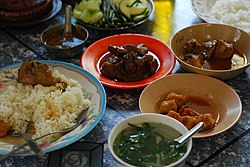Burmese curry/ja: Difference between revisions
Created page with "== 用語{{Anchor|Terminology}} == ビルマ語には「カレー」を意味する単一の単語は存在しない。最も近い近似は''ヒン''({{lang|my|ဟင်း}})という単語で、ご飯と一緒に食べられるほとんどのタンパク質ベースの料理を指すのに使われる。ビルマ風カレーは、一般的に調理法、含まれる材料、または地域によって分類できる。" |
Created page with "最も一般的な種類は''シビャン''({{lang|my|ဆီပြန်}};{{lit|oil returns}})と呼ばれ、調理後に肉汁と肉から油の層が分離するのが特徴である。この名前自体は使用される調理技術を指す。''シビャン''では、カレーの材料を水と油の混合物で煮込み、水が完全に蒸発して油の層が分離して上部に浮き上がるまで煮詰めることで、生で強烈なカレーペース..." |
||
| Line 29: | Line 29: | ||
[[:en:Burmese language|ビルマ語]]には「カレー」を意味する単一の単語は存在しない。最も近い近似は''ヒン''({{lang|my|ဟင်း}})という単語で、ご飯と一緒に食べられるほとんどのタンパク質ベースの料理を指すのに使われる。ビルマ風カレーは、一般的に調理法、含まれる材料、または地域によって分類できる。 | [[:en:Burmese language|ビルマ語]]には「カレー」を意味する単一の単語は存在しない。最も近い近似は''ヒン''({{lang|my|ဟင်း}})という単語で、ご飯と一緒に食べられるほとんどのタンパク質ベースの料理を指すのに使われる。ビルマ風カレーは、一般的に調理法、含まれる材料、または地域によって分類できる。 | ||
最も一般的な種類は''シビャン''({{lang|my|ဆီပြန်}};{{lit|oil returns}})と呼ばれ、調理後に肉汁と肉から油の層が分離するのが特徴である。この名前自体は使用される調理技術を指す。''シビャン''では、カレーの材料を水と油の混合物で煮込み、水が完全に蒸発して油の層が分離して上部に浮き上がるまで煮詰めることで、生で強烈なカレーペーストの材料が適切に混ざり合い、味がまろやかになる。もう一つの一般的な種類のカレーは''ナッ''({{lang|my|နှပ်}};{{Literal translation|tenderized}})と呼ばれ、ヤギ肉のような野性的なタンパク質を煮込んだり、ゆっくり煮込んだりする。他のビルマ風カレーの名前は通常、''–ヒン''({{lang|my|–ဟင်း}})または''–チェッ''({{lang|my|–ချက်}})が接尾辞として付けられる。 | |||
<div lang="en" dir="ltr" class="mw-content-ltr"> | <div lang="en" dir="ltr" class="mw-content-ltr"> | ||
Revision as of 14:30, 27 June 2025
| ビルマ風カレー | |
|---|---|
 いくつかのビルマ風カレーを特徴とする伝統的な食事。 | |
| 種類 | カレー |
| フルコース | 主菜 |
| 発祥地 | ミャンマー(ビルマ) |
| 関連食文化 | ビルマ料理 |
| 提供時温度 | 温かい、または常温 |
| 主な材料 | カレーベース(玉ねぎ、ニンニク、唐辛子、ショウガ、ウコン)、肉、魚介類、野菜 |
| 派生料理 | 多数;下記のリストを参照 |
ビルマ風カレーは、ビルマ料理における多様な料理群を指す。これらは、香り豊かなカレーベースで肉や野菜を煮込んだり、シチューにしたりして作られる。ビルマ風カレーは、新鮮なハーブや香辛料に加えて乾燥スパイスを使用し、しばしば辛さが控えめである点で、他の東南アジアのカレー(例:タイカレー)とは一般的に異なる。ビルマ風カレーは国内のカレーハウスで readily available であり、伝統的にご飯と様々な副菜、スープ、そしてアトケと呼ばれるビルマ風サラダと共に供される。ビルマ風カレーはまた、ナンビャー、パラタ、アルー・プーリ、トシェイのようなインドのパンと一緒に食べることもできる。
材料
ほとんどのビルマ風カレーを調理する際には、通常、玉ねぎ、エシャロット、ニンニク、唐辛子、ショウガなどの新鮮な香辛料と、ウコン粉やパプリカの形の乾燥スパイスを組み合わせたカレーベースが使われる。チリパウダーやガラムマサラのようなスパイスミックス(ビルマ語では総称的にマサラ(မဆလာ)と呼ばれる)などの他の乾燥スパイスも、多くのビルマ風カレーに登場する。ビルマのマサラスパイスブレンドは、通常、挽いたシナモンまたはカッシア、カルダモン、クローブ、黒胡椒から構成される。
カレーベースと乾燥スパイスは、シー・タッ(ဆီသတ်、lit. 'to kill the oil')と呼ばれる工程で、加熱した油で炒められる。一部のビルマ風カレーでは、レモングラス、カレーリーフ、ピンダウティンなどの新鮮なハーブや、新鮮なタマリンドペーストも必要とされる。シャン族やカチン族のカレーでは、ガランガルやのこぎりコリアンダーなどの新鮮なハーブがより自由に使われる一方、モン族のカレーではマリアン・プラムが酸味付けとしてよく使われる。ビルマ風カレーは一般的に魚醤、塩、または/およびンガピ(発酵エビまたは魚のペースト)で味付けされ、伝統的にピーナッツ油とゴマ油を混ぜたもので調理される。
用語
ビルマ語には「カレー」を意味する単一の単語は存在しない。最も近い近似はヒン(ဟင်း)という単語で、ご飯と一緒に食べられるほとんどのタンパク質ベースの料理を指すのに使われる。ビルマ風カレーは、一般的に調理法、含まれる材料、または地域によって分類できる。
最も一般的な種類はシビャン(ဆီပြန်;lit. 'oil returns')と呼ばれ、調理後に肉汁と肉から油の層が分離するのが特徴である。この名前自体は使用される調理技術を指す。シビャンでは、カレーの材料を水と油の混合物で煮込み、水が完全に蒸発して油の層が分離して上部に浮き上がるまで煮詰めることで、生で強烈なカレーペーストの材料が適切に混ざり合い、味がまろやかになる。もう一つの一般的な種類のカレーはナッ(နှပ်;lit. 'tenderized')と呼ばれ、ヤギ肉のような野性的なタンパク質を煮込んだり、ゆっくり煮込んだりする。他のビルマ風カレーの名前は通常、–ヒン(–ဟင်း)または–チェッ(–ချက်)が接尾辞として付けられる。
List of Burmese curries

The repertoire of Burmese curries has not been codified. Common variations of Burmese curries are listed below.
Pork
- Pork sibyan (ဝက်သားဆီပြန်) – classic Burmese curry with fatty cuts of pork
- Pork hnat (ဝက်သားနှပ်) – a sweetened pork curry braised with vinegar and soy sauce
- Pork and pickled mango curry (ဝက်သားသရက်သီးသနပ်ချက်) – a sour and sweet pork curry cooked with pickled mangoes
- Pork tripe sibyan (ဝက်ကလီစာဆီပြန်) – a curry of pork intestines and viscera (kaliza)
- Red braised pork curry (ဝက်သားနီချက်) – a sweet braised curry of caramelized pork belly and soy sauce similar to Chinese red braised pork belly
- Fermented bean paste pork curry (ဝက်ပုန်းရည်ကြီး) – a curry of pork cooked with pon ye gyi (fermented bean paste)
- Pork and bamboo shoot curry (ဝက်သားမျှစ်ချဉ်) – a sour curry of pork and pickled bamboo shoots
- Pork meatball sibyan (ဝက်သားလုံးဆီပြန်) – a curry of fried pork meatballs cooked in gravy
- Fermented tea leaf pork hnat (ဝက်သားလက်ဖက်နှပ်) – a sour and spicy curry of pork braised with lahpet (pickled tea leaves)
Poultry
- Chicken sibyan (ကြက်သားဆီပြန်) – the classic Burmese curry, served with a thick gravy of aromatics
- Bachelor's chicken curry (ကြက်ကာလသားချက်) – a red and watery chicken curry cooked with calabash
- Kachin-style chicken curry (ကြက်ကချင်ချက်) – an herbal curry of chicken cooked with basil, sawtooth coriander, Vietnamese coriander, and dried metlin bark
- Mon-style chicken curry (ကြက်မွန်ချက်) – a watery chicken curry, cooked with dried marian plum, lemongrass stalks and sawtooth coriander
- Chicken and potato curry (ကြက်သားဟင်း) – an Indian-inspired curry of chicken and potatoes cooked with a masala spice mix
- Chicken and chickpea curry (ကြက်သားကုလားပဲချက်)
- Duck sibyan (ဘဲသားဆီပြန်) – a curry of duck cooked with dried spices (e.g., star anise or cumin), and served with a thick gravy of aromatics
Goat and beef
- Beef hnat (အမဲနှပ်) – a braised beef curry similar to Indonesian rendang
- Goat hnat (ဆိတ်သားနှပ်) – a braised goat curry spiced with masala, cinnamon sticks, bay leaf, and cloves
- Goat and chickpea curry (ဆိတ်သားကုလားပဲချက်)
Fish and seafood
- Fried fish curry (ငါးကြော်ချက် or ငါးကြော်နှပ်) – a curry of deep-fried steak cuts of fish and tomatoes
- Steamed hilsa curry (ငါးသလောက်ပေါင်း) – a curry of hilsa fish and tomatoes, which is slowly simmered to melt the fish bones
- Sardine curry (ငါးသေတ္တာချက်) – a curry of sardines cooked with tomatoes
- Prawn sibyan (ပုစွန်ဆီပြန်) – a curry of whole prawns cooked in a sibyan gravy and shrimp oil (ပုစွန်ဆီ), similar to tomalley
- Snakefish intestine sibyan (ငါးရံ့အူဆီပြန်) – a curry of striped snakefish intestines
- Eel sibyan (ငါးရှဉ့်ဆီပြန်)
- Catfish and morinda sibyan (ငါးခူရဲယိုရွက်ဆီပြန်) – a curry of walking catfish and morinda leaves
Other
- Egg curry (ဘဲဥချဥ်ရည်ဟင်း) – a sour curry made with hardboiled duck or chicken eggs, cooked in tamarind paste and mashed tomatoes
- Eggplant curry (ခရမ်းသီးချက်) – a curry of slow-cooked eggplants and tomatoes
- Lablab bean hnat (ပဲကြီးနှပ်) – a curry of braised lablab beans
- Roselle curry (ချဉ်ပေါင်ချက်) – a sour curry of roselle leaves, bamboo shoots, and dried shrimp
- Khayan thi ngachauk chet (ခရမ်းသီးငါးခြောက်ချက်) – aubergine cooked lightly with a small amount of oil, with dried fish and chilli
- Kima palata (ကီးမားပလာတာ) – a paratha stuffed with curried ground meat (keema)
- Pyay palata (ပြည်ပလာတာ) – a salad of paratha, chicken and potato curry, and raw onions
- Tofu curry (တိုဟူးချက်) – Sliced Burmese tofu curried with fresh tomatoes, onions and garlic, cooked in peanut oil and fish sauce, and garnished with coriander and green chilli
Noodle curries
Specially prepared curries also form the base for several Burmese noodle dishes, including:
- Ohn no khauk swe (အုန်းနို့ခေါက်ဆွဲ) – a coconut milk noodle soup, served in a broth of chicken curry
- Shwedaung khauk swe (ရွှေတောင်ခေါက်ဆွဲ) – a dry noodle dish of egg noodles, served with chicken curry and coconut milk
- Nangyi thoke (နန်းကြီးသုပ်) – a salad of thick rice noodles, mixed with chicken curry and gravy
- Panthay khauk swe (ပန်းသေးခေါက်ဆွဲ) – a fried noodle dish of Chinese Muslim origin, served with a chicken curry cooked in a blend of spices including cardamom, cloves, star anise, and bay leaf
Regional adaptations
Kaeng hang le

Kaeng hang le is a pork curry and a regional specialty in Northern Thailand. It is a local adaptation of similar Burmese pork curries; the name "hang le" is derived from the Burmese word "hin lay" (ဟင်းလေး, transcribed hang le), which means "heavy curry." Many restaurants in Chiang Mai call it ‘Burmese curry.’
Khow suey

Khow suey, also known as khausa, is a South Asian adaptation of the Burmese coconut milk curry noodle soup called ohn no khao swè. It was introduced to the region by the Memon community of India who adapted this dish, likely coinciding with the emigration of South Asians from Burma in the 1960s, and is now a Memon specialty.
関連項目
| この記事は、クリエイティブ・コモンズ・表示・継承ライセンス3.0のもとで公表されたウィキペディアの項目Burmese curry(20 December 2024, at 22:52編集記事参照)を翻訳して二次利用しています。 |